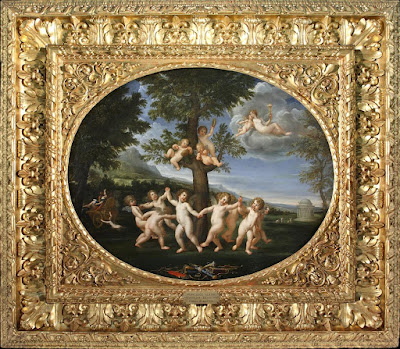 |
| Francesco Albani Phoebus Apollo with Personifications of the Seasons, Hours and Planets ca. 1616 ceiling fresco Palazzo Verospi, Rome |
 |
| Francesco Albani Dancing Amorini 1622-23 oil on copper Pinacoteca di Brera, Milan |
 |
| Francesco Albani Abduction of Europa before 1660 oil on canvas private collection |
 |
| Francesco Albani Apollo and Daphne ca. 1615-20 oil on copper Musée du Louvre |
 |
| Francesco Albani Salmacis and Hermaphroditus ca. 1620 oil on copper Musée du Louvre |
 |
| Francesco Albani Sleeping Cupid ca. 1625-50 oil on canvas National Museum, Warsaw |
 |
| Francesco Albani St Francis at Prayer before a Crucifix after 1630 oil on copper Musée du Louvre |
 |
| Francesco Albani Portrait of Andrea Calvi 1636 oil on canvas National Museum of Wales, Cardiff |
 |
| Francesco Albani Venus attended by Nymphs and Cupids ca. 1633 oil on canvas Museo del Prado, Madrid |
 |
| Francesco Albani Mars and Venus before 1660 oil on canvas Chiswick House, London |
 |
| Francesco Albani The Annunciation ca. 1620 oil on copper Musée du Louvre |
 |
| Francesco Albani Virgin and Child in Glory with St Jerome and St Francis ca. 1640 oil on canvas Pinacoteca Nazionale di Bologna |
 |
| Francesco Albani Holy Family after 1610 oil on copper Dulwich Picture Gallery, London |
 |
| Francesco Albani Baptism of Christ (detail) ca. 1620-24 oil on canvas Pinacoteca Nazionale di Bologna |
 |
| Francesco Albani Virgin and Child in Glory with St Sebastian and St Roch 1635 oil on canvas Collegiata di San Giovanni Battista, San Giovanni in Persiceto |
"Francesco Albani – Bolognese painter, a pupil first of Denys Calvaert, then of the Carracci. He followed Annibale Carracci to Rome shortly after 1600, carrying out his designs for frescos in S. Giacomo degli Spagnuoli, 1602-7. In 1609 he painted decorative frescoes in the Palazzo Giustiniani (now Odescalchi) and c. 1616 in the Palazzo Verospi (now Credito Italiano) where his growing fascination with Raphael is noticeable. In 1616 he returned to Bologna, where his lyrical and rather slight talent was at its best in representations of myth and allegory in landscape. . . . In his later years he became increasingly involved in the theoretical defence of Classicism."
– Erika Langmuir and Norbert Lynton, Yale Dictionary of Art and Artists (2000)